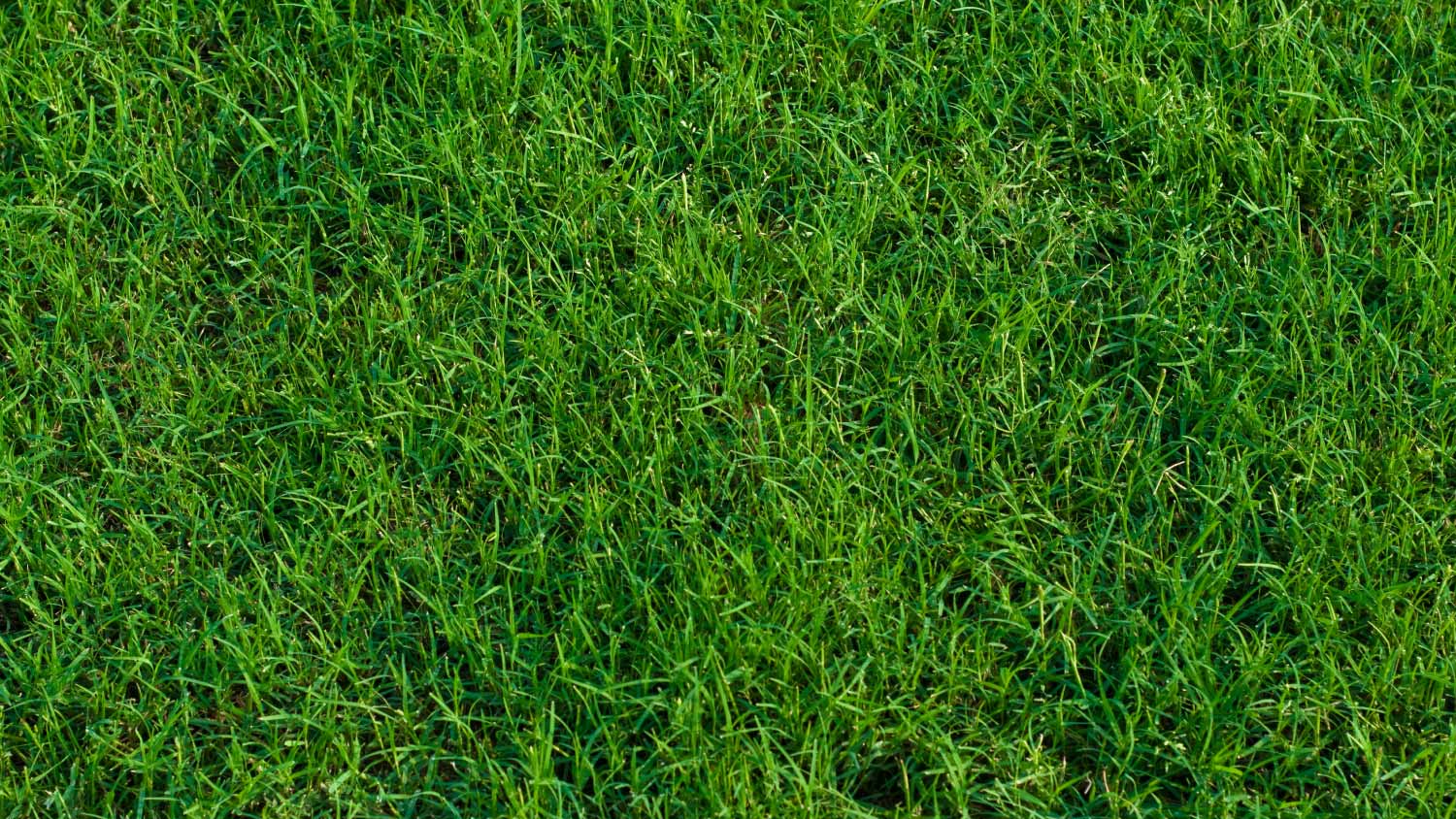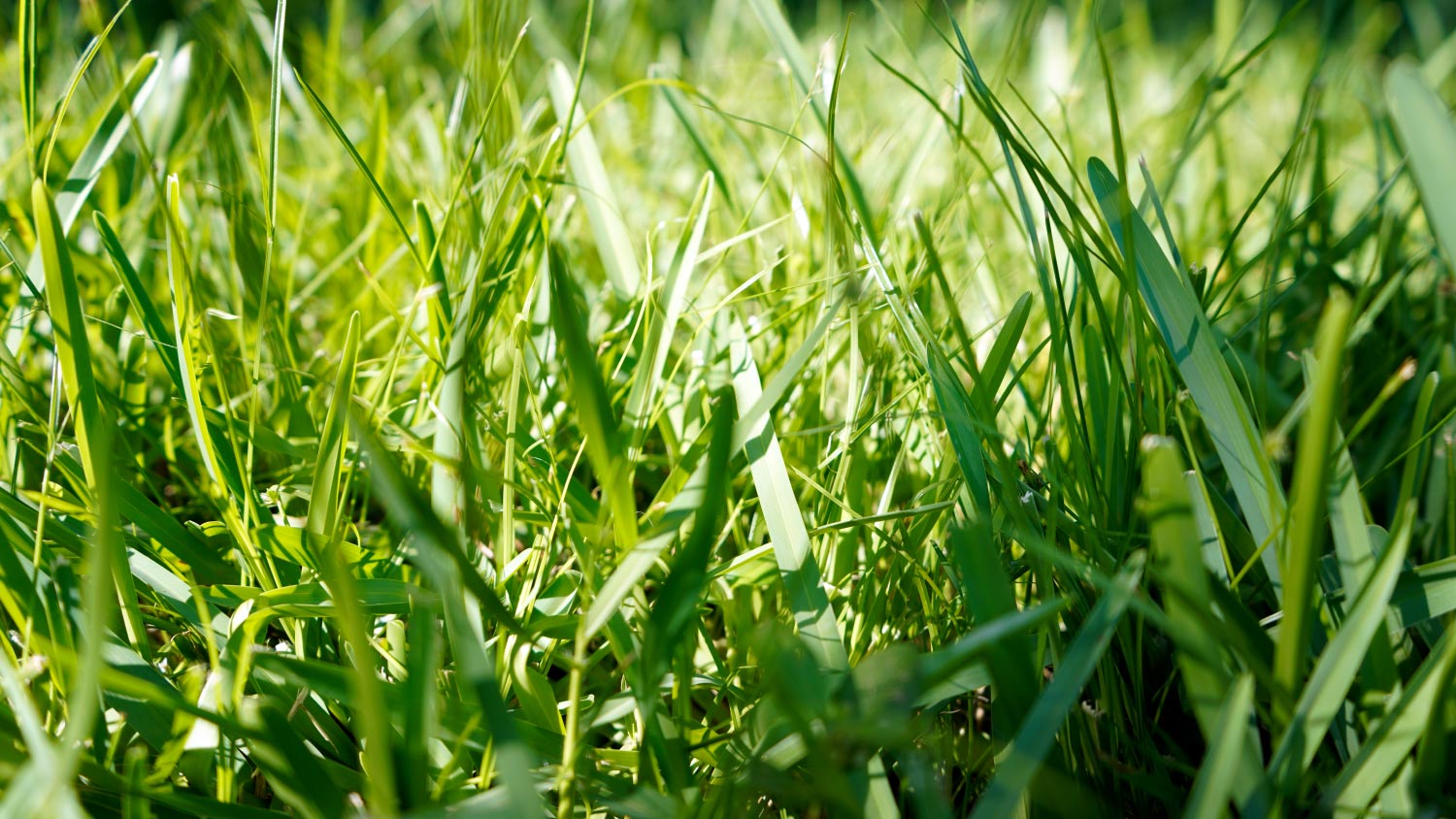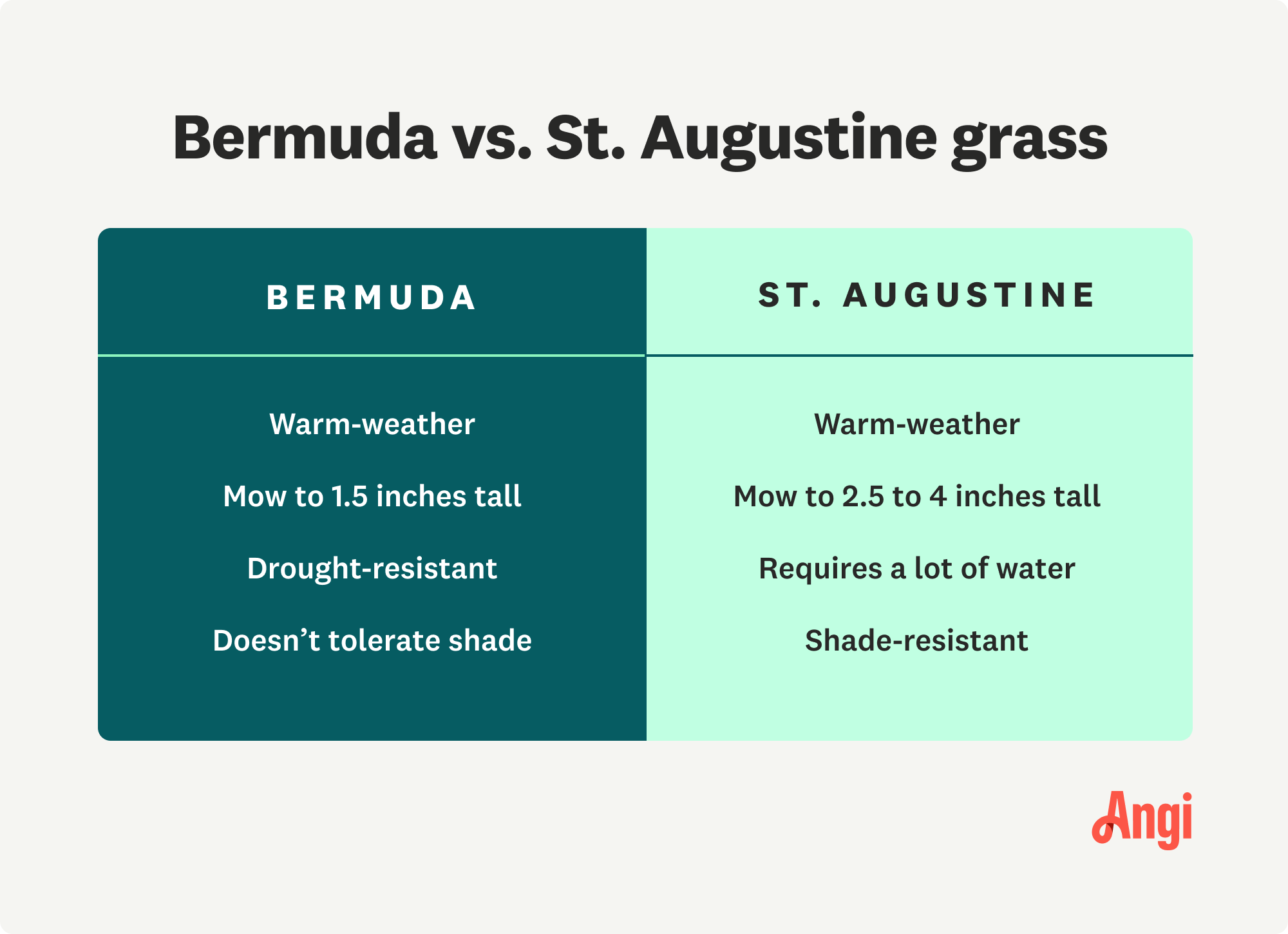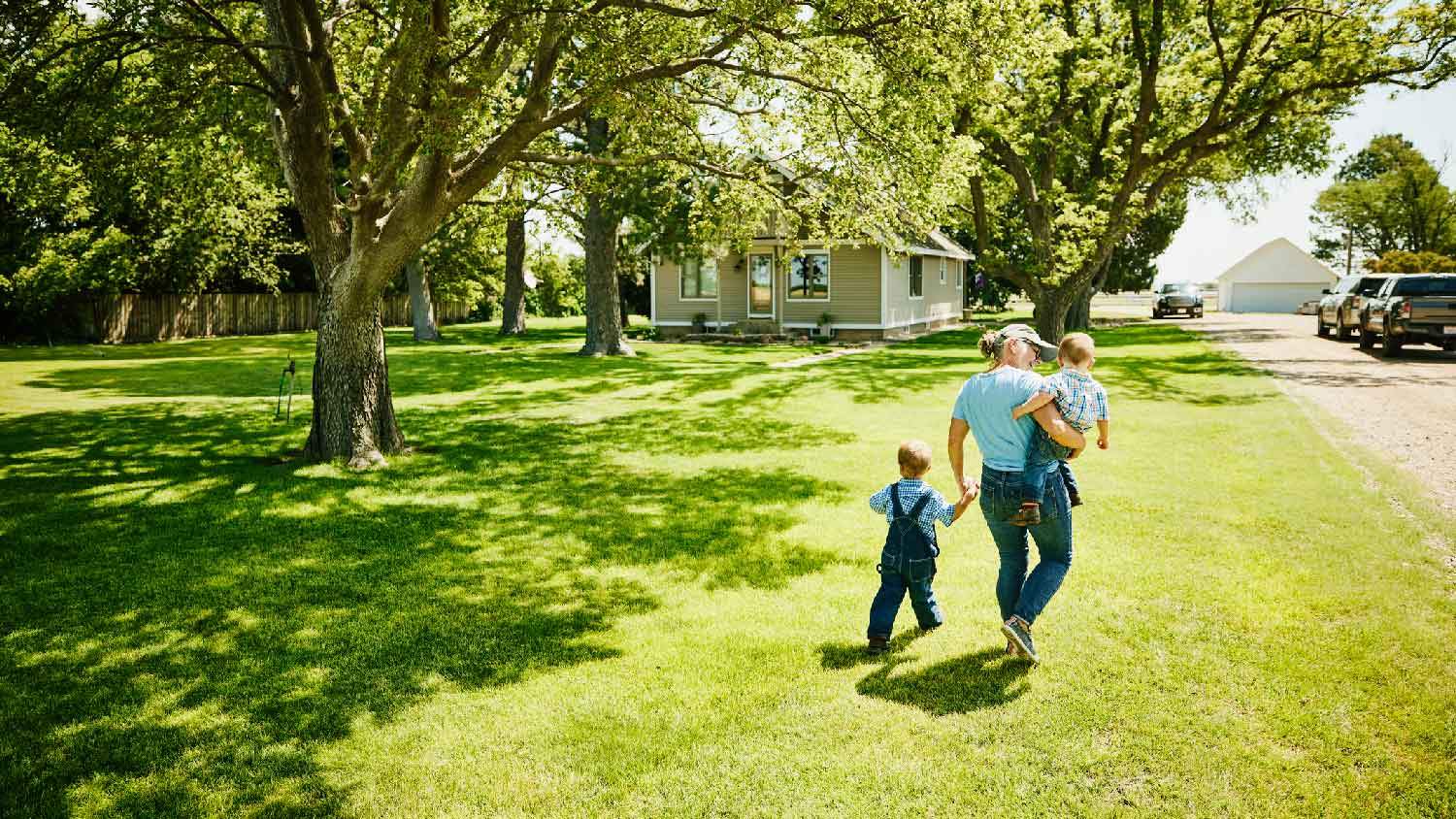What Is Bermuda Grass? Pros, Cons and How to Grow
You don’t have to live in Bermuda to enjoy this warm-weather grass


Bermuda grass is a warm-season grass that thrives in regions with hot summers and mild winters.
It flourishes in areas with full sun exposure and well-draining soil.
Bermuda grass is an excellent choice for lawns across the southern United States and coastal regions.
Bermuda grass exhibits remarkable resilience to high temperatures, drought conditions, heavy foot traffic, and soil salinity.
Maintaining Bermuda grass requires significant effort due to its high maintenance demands and the need for regular nutrient supplementation.
If you’re searching for the perfect warm-season grass to add to your backyard, it’s no surprise you’re considering Bermuda grass—it thrives much better in the summer heat than other grasses. Read on to learn more about Bermuda grass, how to properly care for it, and the different types.
| Category | Classification |
|---|---|
| Kingdom: | Plantae |
| Order: | Cyperales |
| Family: | Poaceae |
| Subfamily: | Chloridoideae |
| Genus: | Cynodon Rich |
| Class: | Liliopsida |
What Is Bermuda Grass?
Bermuda grass is a warm-season grass, meaning it’s at its most lush in late spring and summer, and during cold months, it turns dormant and brown. But if you live in a fairly frost-free climate, you won’t have to worry about your lawn losing its vibrancy for a few months out of the year.
This grass type is admired for its durability and resiliency against plenty of foot traffic, making it a very popular option for athletic fields, golf courses, and homes.
Fun fact: Bermuda grass has an extensive list of nicknames. Though its scientific name is Cynodon dactylon, you may see this type of grass referred to as Dhoob, ethana grass, devil’s grass, dog’s tooth grass, scutch grass, or wiregrass.
What Does Bermuda Grass Look Like?

At its best, Bermuda grass has a powerful light-to-dark green color and a medium texture. Its compact leaves have a sharp point and often have small hairs where the leaf blade meets the leaf sheath. Bermuda grass has a recognizable seed head that resembles a bird’s foot. Also, it spreads laterally thanks to its hardy system of above- and below-ground stems that assist its rapid growth.
Is Bermuda Grass Good for Lawns?
Since it’s a warm-season grass, Bermuda grass grows best in regions with warm climates and plenty of sunlight. It thrives in areas where summer temperatures remain consistently higher than 75 degrees Fahrenheit, and winters are mild with minimal frost.
It’s commonly found in the southern United States, in places like Texas, Florida, Georgia, and California. Bermuda grass has extremely poor shade tolerance and grows best in areas that receive full sunlight for most of the day, requiring a minimum of 6 to 8 hours of direct sunlight daily.
Although Bermuda grass is resilient and tolerant of various environmental conditions, it requires regular maintenance to look its best. Regular mowing, watering, fertilization, weed control, proper aeration, and dethatching are essential to promote optimal growth. It’s also worth noting that it has a rapid growth rate, meaning regular edging is necessary to keep it from growing where it isn’t wanted.
Pros and Cons of Bermuda Grass
Many of Bermuda grass’ pros and cons overlap, depending on geographic location. What makes the grass beloved in warmer climates makes it a lackluster nuisance in cooler climates. For example, in some areas of the United States, Bermuda grass is often used to coat exquisite golf courses and athletic fields. At the same time, it’s considered an invasive weed in northern states, where it can spread onto cracks in sidewalks. Here is a closer look at the pros and cons of Bermuda grass.
| Pros | Cons |
|---|---|
| High sun, heat, and drought tolerance | Low cold tolerance |
| Can withstand heavy foot traffic | Not suitable for shaded areas |
| Grows and spreads quickly, helpful for filling in brown/bare patches in the lawn | Requires frequent mowing and may aggressively spread into non-grass areas like flowerbeds |
Pros of Bermuda Grass
High sun, heat, and drought tolerance: Bermuda grass prefers direct sunlight and can withstand daytime temperatures upward of 100 degrees. Plus, its deep roots help it endure periods of drought.
Resilience: This grass’ extensive root system allows it to handle heavy use, including significant foot traffic, making it ideal for lawns and athletic fields.
Rapid growth rate: Bermuda grass grows fast and spreads quickly, which can be helpful if your lawn has brown patches.
Cons of Bermuda grass
Low cold tolerance: In cooler temps, Bermuda grass can weaken and go dormant, turning a dull brown hue. You’ll also notice slowed growth when it’s colder.
Shade intolerance: Bermuda grass may not be the right choice for your lawn if you have several trees in your yard. This grass type needs direct sunlight, so you might find thin spots in heavily shaded areas.
Rapid growth rate: You may find yourself mowing more often with this type of grass. It can also aggressively spread into more curated areas, such as flowerbeds.
Types of Bermuda Grass
There are two categories of Bermuda grass: common and hybrid. Common, or seeded, Bermuda grass is the more predominant type. Hybrid Bermuda grass, or sterile vegetative hybrids, is a cross-product of common Bermuda grass and African Bermuda grass.
Check out these varieties of hybrid Bermuda grasses that are ideal for home lawns.
Popular Common Bermuda Grass Varieties
Blackjack: With a dense green color and a carpet-like density, this grass is a homeowner favorite. This grass is also more tolerant of cooler temperatures than other Bermuda grass varieties.
Ormond: You’ll recognize this grass from its bluish hue and small, thin leaves. It can withstand different lawn diseases but can’t tolerate cold temperatures.
Yuma: A fine leaf texture and emerald hue give this variety a luxe look. Yuma can handle full sun exposure but has slightly stunted growth, as compared to other Bermuda varieties.
Popular Hybrid Bermuda Grass Varieties
GN-1: Aggressive lateral growth allows this variety to recuperate quickly. GN-1 is identifiable by its dark green color.
Tiflawn: This hybrid emerged in 1952 and is a solid choice for recreational areas. Dense with a dark color, Tiflawn has a healthy growth rate and recuperates fast.
Tifway: This medium-textured version has a higher pest tolerance than other Bermuda grass varieties.
When to Plant Bermuda Grass
For optimal results, you should plant Bermuda grass in the late spring. New Bermuda sod, seed, and grass plugs thrive best when frost no longer poses a threat and temperatures remain upwards of 80 degrees Fahrenheit.
Ideal warm and dry conditions will allow grass seed to germinate within a week. Testy conditions will cause grass seed germination to take roughly three weeks or longer. You can expect your fresh lawn to fully grow within three months.
How to Plant Bermuda Grass

You can plant Bermuda grass around your home in a few different ways. The most popular approaches to incorporating this turf into home landscaping are sodding, seeding, and grass plugs.
If you enjoy instant gratification, sodding will get you a clean, full lawn the quickest. Keep in mind that the average cost of sod installation is $2,000 on average. If you have the time to tend to your yard, you might consider spreading
Bermuda grass seeds or planting grass plugs. Both seeds and grass plugs will require patience before you start to see the intended green results.
How Much Bermuda Grass Seed Do You Need?
For establishing a new lawn, seeding rates for Bermuda grass are around two to three pounds of seed per 1,000 square feet. It’s always a good idea to reference the seed manufacturer’s guidelines for the most accurate recommendations. Below are some estimates based on the lawn size.
| Lawn Size | Grass Seed Needed (Pounds) |
|---|---|
| 1,000 square feet | 2–3 |
| 2,000 square feet | 4–6 |
| 3,000 square feet | 6–9 |
| 4,000 square feet | 8–12 |
| 5,000 square feet | 10–15 |
| 1/4 acre | 22–33 |
| 1/2 acre | 44–66 |
| 1 acre | 87–131 |
How to Grow Bermuda Grass
You can start growing Bermuda grass from seed or sod. The growth method depends on your budget and how fast you want the grass to grow. Sod roots much faster than sowing seed, but it’s more costly.
How to Grow Bermuda Grass from Seed
Here are the basic steps for growing Bermuda grass from seed:
Time it right: Wait until the weather warms to plant Bermuda grass seed. The best time to sow seed is during late spring or early summer when temperatures exceed 65 degrees Fahrenheit.
Prep the soil: Start by clearing the area of debris, rocks, and weeds, then loosen the soil with a rake or tiller to a depth of about 2 to 3 inches. You should also test the soil's pH level to see if it's within range that Bermuda grass prefers—pH 6 and 7.
Sow the seed: Spread the seed evenly over the entire area. You can use a seed spreader to tackle the task efficiently.
Water thoroughly: Water the seed in, but do not oversaturate. Keep the soil moist during the germination period, which is about 7 to 14 days.
Fertilize if needed: You don't want to fertilize too early because it can burn the seeds and kill them. Wait at least 4 to 6 weeks after the seeds germinate to fertilize. Make sure to use a starter fertilizer that is high in phosphorus to help root development.
How to Grow Bermuda Grass From Sod
If you would rather start your Bermuda grass from sod, use these steps:
Lay at the right time: Similar to sowing seeds, you want to ensure you lay the sod during the warmer seasons, such as late spring or early summer.
Prepare the area: Remove existing grass, weeds, and any debris from the area. You need to level the area to make it smooth to lay the sod. You may have to fill in low spots with additional soil if needed.
Get the soil ready: Like with seed, you will need to loosen the top layer of the soil—between 2 to 3 inches deep to allow the roots to establish. Remember to test the soil to ensure it is healthy and has optimal pH levels for Bermuda grass.
Water soil: You should moisten the soil before laying the sod. Dry soil draws nutrients from grass, so watering first can lower the temperature and help the roots to take hold.
Lay the sod: Stagger the sod in a bricklike pattern and ensure each piece fits snugly together. Once you lay the sod, you will need to press it down with a roller to eliminate air pockets.
Water sod thoroughly: You should water the sod immediately after laying it. Give it a deep watering to ensure it reaches several inches down into the soil.
Wait and fertilize: Similar to sowing Bermuda grass seed, you should wait at least 4 to 6 weeks before applying fertilizer. Make sure to find a balanced fertilizer and follow the manufacturer's directions for the best results.
How to Care for Bermuda Grass
Whether you’re a DIY-er or prefer to hire lawn care experts, it will take more than the earth’s elements to keep your grass looking neat. Follow these additional steps to maintain your yard’s pristine condition.
Sunlight
Bermuda grass grows best with lots of sunlight. It requires at least 4 hours of direct sunlight per day. Inadequate light means inadequate photosynthesis for this grass type.
There are a few ways a Bermuda lawn will indicate it’s not getting enough light. It will either start to thin out, grow elongated leaves or stems, or suffer from turf disease since its resistance to infection decreases with less sunlight. If your lot primarily experiences low light, you may be better off with a different type of grass.
Soil
Bermuda grass grows well in slightly acidic soil with a pH of 6 to 7, and it can tolerate a pH of 5.5. Conduct a soil test to check out the pH levels and present nutrients. If the soil tests higher than a pH of 7, you can apply sulfur to lower it, especially if you’re about to plant Bermuda grass.
Climate
Bermuda grass is best suited for warmer climates with milder winters. Temperatures below 30 degrees Fahrenheit can kill the grass’ leaves and stems, and average temperatures below 50 degrees Fahrenheit will halt growth and cause discoloration. There is no singular, universal approach to caring for Bermuda grass, but there are things you can do throughout the year—no matter the climate—to help it develop and flourish. No matter the climate, Bermuda grass needs direct sunlight, fertilization, and semi-frequent watering.
Mowing
Bermuda grass has a considerably high growth rate. To properly upkeep your yard’s appearance, it’s important to mow it at least once a week. Neglecting to mow your lawn can quickly turn it into an overgrown landscape.
If you’re unable to add another task to your weekly schedule, you might consider opting for professional services. A professional lawn-mowing service costs anywhere from $50 to $210, depending on the size of your yard.
Aerating
Lawn aeration removes thatch: loose materials in your lawn between the soil and grass vegetation. While some thatch is fine for your land, a buildup can disrupt grass from absorbing water, oxygen, and fertilizer. Too much thatch also increases your chances of dealing with harmful vegetation diseases and pests.
Aerating your lawn grants its soil a healthier exchange of gasses with the air. Soil releases carbon dioxide and essentially breathes in fresh oxygen. The process of lawn aeration also reduces runoff and puddling, enabling your grass roots to experience a better intake of both water and fertilizer. The easier your yard can absorb water and fertilizer, the easier it will be to maintain. Since Bermuda grass is a warm-season grass, it’s best to aerate when the weather starts to warm up.
Watering
Bermuda grass has a high tolerance for drought, but that doesn’t mean it’s impenetrable. If it doesn’t receive an appropriate amount of water, it can turn brown, leaving your lawn looking neglected.
Fortunately, you can preserve your home’s curb appeal by providing Bermuda grass with the recommended amounts of water per season, as listed below.
Spring: ½–¾ inch per week
Summer: 1–1½ inches per week
Fall: 1 inch of water every month
Winter: 1 inch of water every month
Watering your yard adequately each season fosters strong, deep roots for your grass. The deeper your Bermuda grass roots, the more nutrients they can pull from the soil, boosting the appearance and livelihood of your grass.
Fertilizing
Fertilization reduces weeds and improves the overall growth of your lawn, as it strengthens roots for greater water absorption. Better absorption prevents flooding certain spots in your lawn and creating bare dirt spots throughout your sod.
Commercial fertilizers have varying quantities of nitrogen, phosphorus, and potassium. The balance of these three elements is known as the NPK ratio. For Bermuda grass, look for an NPK ratio high in nitrogen, offers little to no phosphorus, and has a minimal amount of potassium. For example, a 21-3-6 ratio would work well for a Bermuda lawn.
As warm weather approaches, use a quick-release fertilizer until your lawn appears full and green. Then, switch to a slow-release grass fertilizer to avoid an overgrown lawn. Aim to fertilize your grass about once per month.
Insect Control
Warmer weather often invites a variety of insects to your lawn, making insect control a critical step to growing and keeping a thick lawn. The most common insects found in Bermuda grass include:
Grub worms
Cutworms
Sod webworms
Fall armyworms
Billbugs
Mole crickets
Fire ants
Nematodes
Bermuda grass mites
It’s best to stop an insect problem before it starts. Regular maintenance practices can help. For example, keeping a regular mowing schedule keeps insects at bay because there’s less to munch on and less surface area for insects to lay their eggs. Fertilizing your lawn also helps curb damage from insects. The more your lawn grows, the thicker the surface layer becomes, making it difficult for insects to move.
Common Weeds
Two types of weeds appear in Bermuda grass: grassy and broadleaf. Grassy weeds sprout from a seed and can go undetected for long periods of time. These weeds, which sprout as a single leaf, include crabgrass, nutgrass, and goosegrass, among others. Broadleaf weeds sprout with two leaves, making them obvious and easy to spot. Common broadleaf weeds include purslane, goosefoot, and spurge. The best way to control common weeds is through frequent lawn care, such as mowing, controlling shaded areas, and fertilizing.
Disease Control
Bermuda grass may be known for its reliability and resilience, but it’s also vulnerable to certain fungal diseases. Protect your lawn from diseases by knowing what causes them in the first place. Common diseases found in Bermuda grass include:
Rhizoctonia solani: This pathogen causes circular brown and yellow patches. You’ll see this in early spring after prolonged periods of wetness and high humidity.
Clarireedia jacksonii: Known as “dollar spot disease,” this disease causes spots the size of a silver dollar, usually appearing in late spring or early summer. Dry soil with low nitrogen levels can cause these spots to appear.
Rust: This is often caused by Puccinia cynodontis, which emerges as small, dark brown pustules on grass blades.
Spring dead spot: Ophiosphaerella causes circular patches to appear, often with a bleached appearance.
Bermuda Grass Yearly Schedule
There’s no one-size-fits-all approach to creating a Bermuda grass calendar. This grass type has differing reactions to varying temperatures. Here’s a basic seasonal plan to consider for your lawn care.
Winter (December, January, February)
Clean up any storm debris.
Fertilize the soil around mid-January.
Invest in the cost of a soil test to test the soil for nutrient deficiencies.
Apply pre-emergent herbicide in late February to prevent weed seedlings from sprouting.
Spring (March, April, May)
Start applying fertilizer and insecticide as temperatures rise and insects become active.
Increase mowing frequency as grass growth accelerates, focusing on the end of spring.
Pull up any emerging weeds.
Apply a preventative fungicide.
Begin aerating your lawn around mid-April.
Summer (June, July, August)
Increase mowing frequency to a couple of times per week.
Stay consistent with fertilizer applications.
Consider irrigating your yard to combat heat stress.
Fall (September, October, November)
Treat your lawn for any worms or pests.
Clean up fallen leaves, acorns, and twigs to prevent the suffocation of grass.
Bermuda Grass vs. Other Types of Grass

Depending on the climate, Bermuda grass can be an excellent contender for your home’s choice of turf. However, homeowners have several options when choosing the best grass type for their yards. If you’re having difficulty deciding, a local lawn service pro can help you weigh your options. Here’s how Bermuda grass stacks up against some of the most popular grass choices.
Bermuda Grass vs. Fescue Grass
When debating Bermuda grass vs. fescue, these two grasses can both endure droughts, but fescue grass can withstand colder temperatures, which cause Bermuda grass to go dormant and turn brown. Bermuda grass is a bit shorter, whereas fescue grass can grow up to 4 inches tall.
Bermuda Grass vs. Kentucky Bluegrass
These types are fast-growing, self-repairing grasses. Kentucky Bluegrass is much softer than Bermuda grass, but both are fairly durable. The main difference is their temperature needs: Kentucky Bluegrass is a cool-weather grass, while Bermuda grass is better suited for warmer temperatures.
Bermuda Grass vs. St. Augustine Grass
Both types are warm-weather grasses, meaning they thrive in warmer temperatures. But you’ll find yourself watering more with St. Augustine grass vs. Bermuda grass. Bermuda grass can handle more foot traffic, while St. Augustine grass is more sensitive.
Bermuda Grass vs. Zoysia Grass
These warm-season grasses are durable and will thrive in the right conditions. But when choosing Bermuda grass vs. Zoysia, Bermuda grass might be the better choice if you’re looking for a faster-growing grass. Zoysia is the lower-maintenance grass out of the two.
Many homeowners in warmer climates like this resilient, hearty grass because it can tolerate excessive heat and drought while developing into a lush lawn. Unlike other grasses, Bermuda grass grows and spreads quickly and can withstand excessive foot traffic. But whether Bermuda grass is good for lawns may depend on your geographic location, as this grass has a low tolerance for cooler temperatures, which causes it to go dormant and turn brown in the winter months.
Bermuda grass is one of the fastest-growing warm-season grasses because of its system of aboveground stems (stolons) and below-ground stems (rhizomes). Adequate water and sunlight in a warmer climate will nurture the spread of Bermuda grass. This rapid growth rate makes Bermuda grass resilient and effective at choking weeds. However, this aggressive advancement can also make the grass difficult to contain and control.
If thrown on the ground and left, some Bermuda seeds will sprout on the surface, but you will have a diminished germination rate. It’s best to cultivate the area before spreading the seeds for optimal results. Rake the area first and then evenly distribute the Bermuda seeds. Cover the space with about ¼ inch of soil before watering the area.
Bermuda grass may be drought-resistant, but it still needs to be watered once or twice a week. The suggested amount of water Bermuda grass needs varies from season to season. Bermuda grass needs about 1 inch of water a week in summer, fall, and winter; it needs up to ¾ inch in spring.















